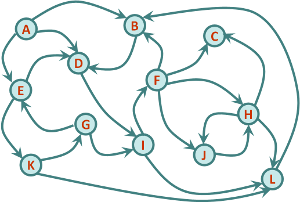Constructing Scenarios Using Cross-Impact Balances
Since its publication in 2006¹, Cross-Impact Balances (CIB) has established itself internationally, above all, as a method for the systematic construction of qualitative and semiquantitative scenarios.² The special feature of the CIB is that it uses qualitative knowledge about the influence relationships between scenario factors using an algorithmic approach, thus making complexity treatable even if the topic under investigation is described in whole or in substantial parts by qualitative knowledge.³ In the CIB approach, future developments and their interaction are interpreted as a qualitative network of influences. Qualitative networks are characterized by the fact that each node of the network can only assume a limited number of discrete, qualitatively described states. The arrows between the nodes stand for a matrix that indicates which state of the source node promotes or inhibits which state of the target node. As a result of the mutual promotion and inhibition between the nodes, 'consistent network configurations' emerge. Each of them forms a self-stabilizing network of node states.
In the CIB approach, future developments and their interaction are interpreted as a qualitative network of influences. Qualitative networks are characterized by the fact that each node of the network can only assume a limited number of discrete, qualitatively described states. The arrows between the nodes stand for a matrix that indicates which state of the source node promotes or inhibits which state of the target node. As a result of the mutual promotion and inhibition between the nodes, 'consistent network configurations' emerge. Each of them forms a self-stabilizing network of node states. For scenario analysis, the most important factors of the system under investigation are defined as the nodes of the network. The main future alternatives for the factors (typically 2-4) are assigned to the nodes as possible node states. Qualitative findings on the promoting or inhibiting influences between the various future developments are collected and their strengths are assessed on an integer scale (e.g., from -3...+3). Together, these data form a 'cross-impact matrix' and the CIB balance algorithm can be used to calculate consistent scenarios for the future of the system. This procedure is demonstrated on the 'Method' page with a simple example.
The necessary information for CIB analysis can be obtained through literature review, expert elicitation, or personal competence of the persons performing the analysis. Since the CIB can include very different kinds of factors and knowledge in the analysis, it is also suitable for interdisciplinary and discursive scenario analysis. Due to its algorithm-based analysis procedure, the CIB is able to search scenario spaces more completely than purely discussion-based scenario analysis. It can thus help to prevent important scenarios from being overlooked or that system knowledge is not fully taken into account in the scenarios.
More information:
¹ Weimer-Jehle W. (2006): Cross-Impact Balances: A System-Theoretical Approach to Cross-Impact Analysis. Technological Forecasting and Social Change, 73:4, 334-361.
² See CIB-Bibliography.
³ The CIB brings together the concepts of morphological analysis (Zwicky 1969), cross-impact analysis (Gordon and Hayward 1968) and Nash equilibria (Nash 1951).